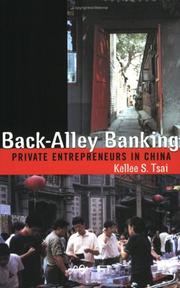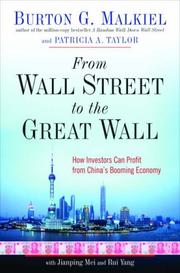| Listing 1 - 10 of 73 | << page >> |
Sort by
|
Book
ISBN: 0804788545 0804787190 9780804788540 9780804787192 Year: 2020 Publisher: Stanford Stanford University Press
Abstract | Keywords | Export | Availability | Bookmark
 Loading...
Loading...Choose an application
- Reference Manager
- EndNote
- RefWorks (Direct export to RefWorks)
Chinese Money in Global Context: Historic Junctures Between 600 BCE and 2012 offers a groundbreaking interpretation of the Chinese monetary system, charting its evolution by examining key moments in history and placing them in international perspective. Expertly navigating primary sources in multiple languages and across three millennia, Niv Horesh explores the trajectory of Chinese currency from the birth of coinage to the current global financial crisis. His narrative highlights the way that Chinese money developed in relation to the currencies of other countries, paying special attention to the origins of paper money; the relationship between the West's ascendancy and its mineral riches; the linkages between pre-modern finance and political economy; and looking ahead to the possible globalization of the RMB, the currency of the People's Republic of China. This analysis casts new light on the legacy of China's financial system both retrospectively and at present—when China's global influence looms large.
Money --- History. --- History --- Australian --- E-books --- S10/0300 --- China: Economics, industry and commerce--Money and banking: general and before 1911
Book
ISBN: 2711778886 Year: 2006 Publisher: Paris Vuibert
Abstract | Keywords | Export | Availability | Bookmark
 Loading...
Loading...Choose an application
- Reference Manager
- EndNote
- RefWorks (Direct export to RefWorks)

ISBN: 9780801489174 0801489172 0801439280 1501717154 Year: 2004 Publisher: Ithaca Cornell University Press
Abstract | Keywords | Export | Availability | Bookmark
 Loading...
Loading...Choose an application
- Reference Manager
- EndNote
- RefWorks (Direct export to RefWorks)
Chinese entrepreneurs have founded more than thirty million private businesses since Beijing instituted economic reforms in the late 1970s. Most of these private ventures, however, have been denied access to official sources of credit. State banks continue to serve state-owned enterprises, yet most private financing remains illegal. How have Chinese entrepreneurs managed to fund their operations? In defiance of the national banking laws, small business owners have created a dizzying variety of informal financing mechanisms, including rotating credit associations and private banks disguised as other types of organizations. Back-Alley Banking includes lively biographical sketches of individual entrepreneurs; telling "ations from official documents, policy statements, and newspaper accounts; and interviews with a wide variety of women and men who give vivid narratives of their daily struggles, accomplishments, and hopes for future prosperity. Kellee S. Tsai's book draws upon her unparalleled fieldwork in China's world of shadow finance to challenge conventional ideas about the political economy of development. Business owners in China, she shows, have mobilized local social and political resources in innovative ways despite the absence of state-directed credit or a well-defined system of private property rights. Entrepreneurs and local officials have been able to draw on the uncertainty of formal political and economic institutions to enhance local prosperity.
Finance --- Financial institutions --- Informal sector (Economics) --- Banks and banking --- S10/0320 --- China: Economics, industry and commerce--Money and banking: since 1949 --- China

ISBN: 9780393064780 Year: 2008 Publisher: New York Norton
Abstract | Keywords | Export | Availability | Bookmark
 Loading...
Loading...Choose an application
- Reference Manager
- EndNote
- RefWorks (Direct export to RefWorks)
It is no secret that China has the world's fastest-growing economy. The trick is how average investors can tap into the opportunities it affords. Investment adviser Malkiel explains why and how the Chinese economy is poised for significant gains in the near future. He highlights not only Chinese firms and industries but also multinationals in the United States and elsewhere that are likely to benefit from China's explosive growth. Following this tour and analysis of investment opportunities in China, including the stock, commodities, real estate, and even art and collectibles markets, the book sets forth a grand strategy, including sample portfolios.--From publisher description.
Book
ISBN: 1000054675 1003016200 9781000054675 9780367859237 9781003016205 9781000054576 1000054578 9781000054620 1000054624 0367859238 9781032237619 Year: 2020 Publisher: London Routledge
Abstract | Keywords | Export | Availability | Bookmark
 Loading...
Loading...Choose an application
- Reference Manager
- EndNote
- RefWorks (Direct export to RefWorks)
Looking from the 11th century to the 20th century, Kuroda explores how money was used and how currencies evolved in transactions within local communities and in broader trade networks. The discussion covers Asia, Europe and Africa and highlights an impressive global interconnectedness in the pre-modern era as well as the modern age. Drawing on a remarkable range of primary and secondary sources, Kuroda reveals that cash transactions were not confined to dealings between people occupying different roles in the division of labour (for example shopkeepers and farmers), rather that peasants were in fact great users of cash, even in transactions between themselves. The book presents a new categorization framework for aligning exchange transactions with money usage choices. This fascinating monograph will be of great interest to advanced students and researchers of economic history, financial history, global history and monetary studies.
Money --- History. --- S10/0300 --- S26/0730 --- S27/0730 --- S38/1020 --- J4562 --- K9482 --- History --- China: Economics, industry and commerce--Money and banking: general and before 1911 --- Taiwan--Banking and finance (incl. public finances) --- Hong Kong--Banking and finance --- Works not related to China and the Far East--Money and banking --- Japan: Economy and industry -- finance -- money --- Korea: Economy and industry -- finance -- money, currency --- E-books
Book
ISBN: 9780801453090 9780801479595 Year: 2014 Publisher: Ithaca : Cornell University Press,
Abstract | Keywords | Export | Availability | Bookmark
 Loading...
Loading...Choose an application
- Reference Manager
- EndNote
- RefWorks (Direct export to RefWorks)
Book
ISBN: 9782251446868 2251446869 Year: 2017 Publisher: Paris Les Belles Lettres
Abstract | Keywords | Export | Availability | Bookmark
 Loading...
Loading...Choose an application
- Reference Manager
- EndNote
- RefWorks (Direct export to RefWorks)
Véritable somme, fruit de plusieurs décennies de recherche, ce livre est à ce jour la synthèse la plus complète sur les monnaies de la Chine ancienne, des origines à la fin de l’Empire (1911). Mobilisant une grande variété de sources, il conduit le lecteur au travers d’une aventure monétaire multiséculaire et, ce faisant, trace une passionnante histoire générale de la Chine.Alors que le monde occidental fonctionnait sur le modèle de la valeur intrinsèque de la monnaie (liée à la valeur de la matière dont elle est constituée), le monde chinois a « inventé » la monnaie fiduciaire : celle dont la valeur repose sur la loi. Dès le xe siècle av. J.-C., les Chinois ont mis au point un système où un objet spécifique est à la fois unité de compte, mesure de la valeur des biens et moyen de paiement et d’échange. Un système avec pour seul signe monétaire une pièce de bronze.À l’aide des textes historiques (annales dynastiques, mémoires au trône, rapports de fonctionnaires) et des découvertes archéologiques les plus récentes, est mise en lumière la différence majeure entre l’image donnée par l’historiographie officielle et la réalité de la circulation monétaire. L’hétérogénéité des espèces en circulation et les pratiques financières montrent tout l’écart qu’il y a entre la monnaie à valeur intrinsèque et la monnaie fiduciaire, cette « remarquable anomalie » aux yeux des Occidentaux.Ce livre est enrichi d’une iconographie exceptionnelle de plus de 370 illustrations, pour la plupart inédites, de 20 cartes et tableaux et d’une bibliographie exhaustive.
Money --- Coins, Ancient --- Coins, Chinese --- Ancient coins --- History. --- China --- Economic conditions. --- Antiquities. --- S10/0300 --- S17/1200 --- China: Economics, industry and commerce--Money and banking: general and before 1911 --- China: Art and archaeology--Numismatics --- History
Book
ISBN: 1623200563 9781623200565 1623200008 1336200677 9781623200008 Year: 2015 Publisher: Honolulu Enrich Professional Publishing
Abstract | Keywords | Export | Availability | Bookmark
 Loading...
Loading...Choose an application
- Reference Manager
- EndNote
- RefWorks (Direct export to RefWorks)
Book
ISBN: 9780470822494 047082249X Year: 2009 Publisher: Singapore ; Hoboken, NJ : John Wiley & Sons,
Abstract | Keywords | Export | Availability | Bookmark
 Loading...
Loading...Choose an application
- Reference Manager
- EndNote
- RefWorks (Direct export to RefWorks)
"China's Emerging Financial Markets is necessary reading for those who seek to understand the strategic direction of this key industry, as well as those who wonder what role China will play in the current global economic crisis."--BOOK JACKET.
Finance --- Banks and banking --- China --- Economic policy. --- 332.0951 --- S10/0320 --- China: Economics, industry and commerce--Money and banking: since 1949 --- Marché financier --- Chine --- Nouveaux pays industrialisés --- Marché financier --- Nouveaux pays industrialisés
Book
ISBN: 9780815726111 Year: 2015 Publisher: Tokyo Asian Development Bank Institute
Abstract | Keywords | Export | Availability | Bookmark
 Loading...
Loading...Choose an application
- Reference Manager
- EndNote
- RefWorks (Direct export to RefWorks)
S10/0320 --- Renminbi --- Foreign exchange rates --- Currency question --- CNY (Money) --- Ren min bi --- RMB (Money) --- Yuan (Money) --- Money --- China: Economics, industry and commerce--Money and banking: since 1949 --- China --- Economic policy --- Economic policy and planning (general)
| Listing 1 - 10 of 73 | << page >> |
Sort by
|

 Search
Search Feedback
Feedback About UniCat
About UniCat  Help
Help News
News